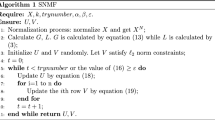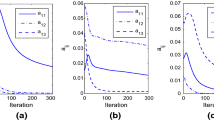Abstract
Nonnegative matrix factorization (NMF) has been successfully used in different applications including computer vision, pattern recognition and text mining. NMF aims to decompose a data matrix into the product of two matrices (respectively denoted as the basis vectors and the encoding vectors), whose entries are constrained to be nonnegative. Unlike the ordinary NMF, we propose a novel NMF, denoted as MMNMF, which considers both geometrical information and discriminative information hidden in the data. The geometrical information is discovered by minimizing the distance among the encoding vectors, while the discriminative information is uncovered by maximizing the distance among base vectors. Clustering experiments are performed on the real-world data sets of faces, images, and documents to demonstrate the effectiveness of the proposed algorithm.


Similar content being viewed by others
References
Paatero P, Tapper U (1994) Positive matrix factorization—a nonnegative factor model with optimal utilization of error estimates of data values. Environmetrics 5(2):111–126
Lee DD, Seung HS (1999) Learning the parts of objects by nonnegative matrix factorization. Nature 401:788–791
Hyvärinen A, Oja E (2000) Independent component analysis: algorithms and applications. Neural Networks 13(4–5):411–430
Hyvärinen A, Karhunen J, Oja E (2001) Independent component analysis. Wiley, New York
Xu W, Liu X, Gong Y (2003) Document clustering based on non-negative matrix factorization. Proc. ACM Conf. Research and Development in Information Retrieval (SIGIR), pp 267–273
Pauca VP, Shahnaz F, Berry M, Plemmons R (2004) Text mining using non-negative matrix factorization. Proc. SIAM Int’l Conf. Data Mining, pp 452–456
Li S, Hou X, Zhang H, Cheng Q (2001) Learning spatially localized, parts-based representation. Proc. IEEE Conf. Computer Vision and Pattern Recognition, pp 207–212
Shahnaza F, Berrya MW, Paucab V, Plemmonsb RJ (2006) Document clustering using nonnegative matrix factorization. Inf Process Manage 42(2):373–386
Pascual-Montano A, Carazo JM, Kochi K, Lehmann D, Pascual-Marqui RD (2006) Nonsmooth nonnegative matrix factorization (nsNMF). IEEE Trans Pattern Anal Mach Intell 28(3):403–415
Cai D, He X, Han J, Huang T (2011) Graph regularized non-negative matrix factorization for data representation. IEEE Trans Pattern Anal Mach Intell 33(8):1548–1560
Ding C, Li T, Jordan MI (2010) Convex and semi-nonnegative matrix factorizations. IEEE Trans Pattern Anal Mach Intell 32(1):45–55
Guan NY, Tao DC, Luo ZG, Yuan B (2011) Manifold regularized discriminative nonnegative matrix factorization with fast gradient descent. IEEE Trans Image Process 20(7):2030–2048
Cui JR, Wen JJ, Li ZM, Li B (2015) Discriminant non-negative graph embedding for face recognition. Neurocomputing 149:1451–1460
Wang Jim JY, Bensmail H, Gao X (2013) Multiple graph regularized nonnegative matrix factorization”. Pattern Recogn 46(10):2840–2847
Yang S, Yi Z, Ye M, He X (2014) Convergence analysis of graph regularized non-negative matrix factorization. IEEE Trans Knowl Data Eng 26(9):2151–2155
Fisher RA (1936) The use of multiple measurements in taxonomic problems. Annals of Eugenics 7(2):179–188
Rao CR (1948) The utilization of multiple measurements in problems of biological classification, J R Statis Soci Series B 10(2):159–203
Lee DD, Seung HS (2001) Algorithms for non-negative matrix factorization,Advances in Neural Information Processing Systems 13, MIT Press, USA
MacQueen J (1967) Some methods for classification and analysis of multivariate observations. Proceedings of 5th Berkeley Symposium on Mathematical Statistics and Probability, University of California Press, pp 281–297
He X, Niyogi P (2003) Locality preserving projections. Proceeding in Conference Advances in Neural Information Processing Systems (NIPS)
M. Belkin, P. Niyogi, “Laplacian eigenmaps and spectral techniques for embedding and clustering,” Advances in Neural Information Processing Systems 14, pp. 585-591, MIT Press, 2001
Fan R. K. Chung, Spectral Graph Theory, Regional Conference Series in Mathematics, no. 92, 1997
He X, Cai D, Yan S, Zhang H (2005) Neighborhood preserving embedding. Proceeding in International Conference on Computer Vision (ICCV)
Lin CJ (2007) On the convergence of multiplicative update algorithms for non-negative matrix factorization. IEEE Trans Neural Networks 18(6):1589–1596
Shi J, Malik J (2000) Normalized cuts and image segmentation. IEEE Trans Pattern Anal Mach Intell 22(8):888–905
Wu Z, Leahy R (1993) An optimal graph theoretic approach to data clustering: theory and its application to image segmentation. IEEE Trans Pattern Anal Mach Intell 15(11):1101–1113
Lovasz L, Plummer M (1986) Matching Theory. Akadémiai Kiadó, North Holland
Cai D, He X, Han J (2005) Document clustering using locality preserving indexing. IEEE Trans Knowl Data Eng 17(12):1624–1637
Wang XZ, Xing HJ, LI Y, Hua Q et al (2014) A study on relationship between generalization abilities and fuzziness of base classifiers in ensemble learning. IEEE Trans Fuzzy Syst. doi:10.1109/TFUZZ.2014.2371479
Wang XZ, Dong LC, Yan JH (2012) Maximum ambiguity-based sample selection in fuzzy decision tree induction. IEEE Trans Knowl Data Eng 24(8):1491–1505
Wang XZ, Dong CR (2009) Improving generalization of fuzzy if-then rules by maximizing fuzzy entropy. IEEE Trans Fuzzy Syst 17(3):556–567
Acknowledgments
This work was supported in part by General Research Fund of the Hong Kong Research Grants Council under Grant PolyU 5134/12E; the National Natural Science Foundation of China under Grants 61170122, 61272210 and 61202311; the Natural Science Foundation of Zhejiang Province under Grants LY13F020011, LY14F010010 and LY14F020009; the Humanities and Social Science Foundation of Ministry of Education of China under Grant 13YJAZH084; the Natural Science Foundation of Jiangsu Province under Grants BK2011003 and BK2011417; the Natural Science Foundation of Huzhou City under Grant 2013YZ05; Huzhou University science research project under Grants KX24063 and KX24058.
Author information
Authors and Affiliations
Corresponding author
Rights and permissions
About this article
Cite this article
Hu, W., Choi, KS., Tao, J. et al. Nonnegative matrix factorization with manifold regularization and maximum discriminant information. Int. J. Mach. Learn. & Cyber. 6, 837–846 (2015). https://doi.org/10.1007/s13042-015-0396-8
Received:
Accepted:
Published:
Issue Date:
DOI: https://doi.org/10.1007/s13042-015-0396-8




